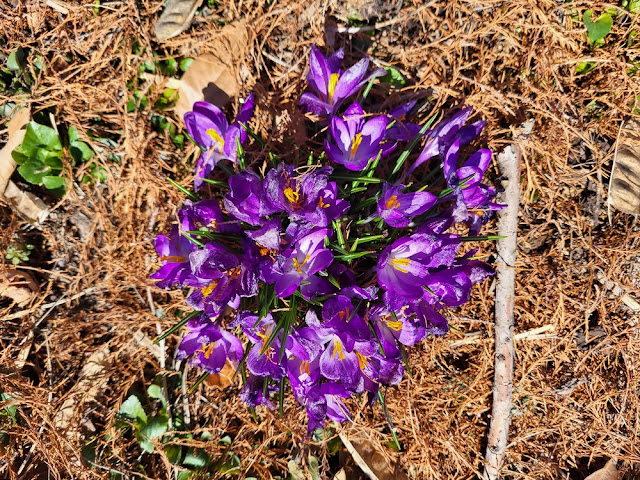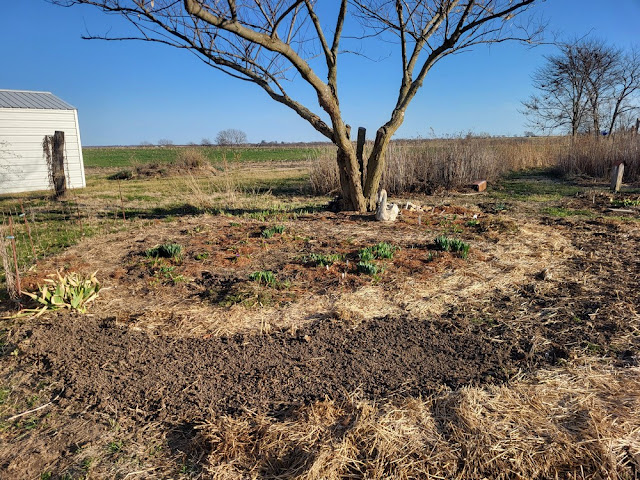
We're now into a string of rainy days, and the ground is too wet to plant. But, I'm happy I didn't lose anything during last week's string of well-below freezing temperatures. I managed to get most everything covered with either garden fleece sheeting or last fall's bald cypress needles (not much difference in performance). I failed to get the Darwin hybrid tulips covered, and when I saw them drooping and water-soaked, I assumed they'd frozen. When you see leaves that look water-soaked (or greasy) and dark, it generally means the cells have frozen and burst, and while the plant may survive, those leaves don't recover from that state.

So imagine my surprise and joy when I saw them today:
They look almost as good as they did before the freezing began. Even the iris beside them showed some freeze damage, which is a good indication of just how cold it was. The iris aren't usually affected by harsh winter weather.
The crocus that were in full flower had a bit of a rough time, but they survived, with new buds opening to somewhat hide the blooms that were freeze damaged. I had a light covering of bald cypress needles over them to offer some protection. They might have fared better with fleece covering, but I'd already enjoyed several days of their beauty before the freeze, and I didn't have enough fleece for everything.
'Ruby Giant'
The plants fully under fleece came out beautifully.
Oriental poppy
Tucked in under an oriental poppy, toadflax looks so sweet. The flower stalks will get tall enough to reach over the poppies if they get enough sun, and don't get shaded out by the faster growing poppies. Their placement was not intentional. When I planted the poppies, I thought the toadflax had died. Surprise!
The rhubarb looked a bit pale because they'd been under fleece for several days even before the freeze. The large leaves don't do well at all when the temperatures dip, so I'm always curious as to why they come up so early. They'll look nice and lush as soon as they can get enough sunlight.
Scilla (Chionodoxa forbesii) - aka Glory of the Snow - are popping out and are a little ahead of the hyacinths for blooming.
Chionodoxa forbesii
And the pasque flowers (Pulsatilla vulgaris) are right there with them.
I had to bring in the seedlings from my cold frame for a couple of nights, but they're back out now, and today it's cloudy, so I've taken off the fleece cover that protects tender seedlings from too much sun.
Over half are annual poppies. Everything I read says not to start poppies indoors because they don't transplant well. I've never had any trouble with that, and in fact, I've never had good results planting the seeds directly outdoors. It's a chore transplanting so many, but it's so satisfying when there's lots of them.
The rose cutting from my 'South Africa' bush actually produced a bloom. So cool. (At least I have it labeled as 'South Africa', but it does look a lot like 'Razzle Dazzle'. I'm going to assume I labeled it correctly - with no reason whatsoever to assume that and plenty of past experience to think otherwise - and assume it's as orange in color as it is because it hasn't been out in the sun. The blossoms on the parent bush are a deep, dark gold.
I got some potatoes in the ground yesterday morning before the rain started. This year I didn't purchase any red potatoes. I got 'All Blue' - a purple variety - just to see what it was like, and 'Yukon Gold', which has become my favorite. They produce well and cook up so creamy and delicious.
A little honey bee scout was out this morning. I hope he decides this is a good place to support a hive.
Fingers crossed that spring has finally arrived.






























